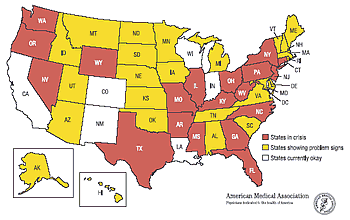Access to quality and affordable healthcare is everyone’s concern. Labor strikes have hit many industries over the past year and the rising cost of healthcare is always an issue. And skyrocketing medical malpractice costs are adding more fuel to the medical industry’s fire.
Physicians nationwide have staged protests decrying the rising costs of medical liability and the undying need for tort reform, holding strikes in West Virginia, work slowdowns in New Jersey, and closures of hospital services such as trauma care in Nevada. Physicians in other states continue to hold rallies demanding tort reform.
The availability and affordability of med-mal insurance has become a national crisis says the American Medical Association, which now categorizes 19 states in crisis because of high insurance rates, the lack of insurers operating in those states and the effect this has on the availability of certain high risk medical specialties.
“The AMA says that 19 states are in crisis but is says that only six states are really secure at this point,” said Dr. Richard Anderson, president of The Doctors Company. “So that leaves you with 44 states total that are either in crisis or close to it.”

According to some reports, the problem has caused an exodus of doctors from states where the crisis is at peak levels, and has deterred new physicians from entering states with the most troubled med-mal markets, although some reports have been disputed.
Nevertheless, the medical liability availability crisis has added to the nation’s already troubled healthcare system, says Anderson.
“The daunting nature of this crisis is so clear that we are rapidly reaching a point where the nation is simply going to have to choose whether it wants to have a viable healthcare system or simply the right to sue every time there is an adverse outcome,” said Anderson.
In January, the Congressional Budget Office issued a report indicating on average, premiums for all physicians nationwide rose by 15 percent from 2000 to 2002—nearly twice as fast as total healthcare spending per person. Increases in premiums were more significant for certain medical specialties: 22 percent for obstetricians/gynecologists and 33 percent for internists and general surgeons.
Anderson commented that there are no easy answers to this national problem, but said substantive tort reform measures, whether they be at the state or federal level, would provide “a good prescription for the U.S. and a very good remedy for some fundamental issues in the legal system.”
Tort costs more
The med-mal market’s sharp rise in premiums over the last several years largely has been due to the growing severity of claims against physicians, hospitals and medical facilities. According to a report by Tillinghast-Towers Perrin, “U.S. Tort Costs: 2003 Update,” since 1975, the increase in medical liability costs has exceeded increases in overall U.S. tort costs, escalating an average of 11.9 percent per year, compared to an average tort cost increase of 9.3 percent annually.
The study also estimated that med-mal tort costs totaled nearly $25 billion in 2002, or $85 per person, compared with $5 per person in 1975. The overall cost of the U.S. tort system in 2002 was reported at $233 billion, a $27.4 billion increase over 2001, representing the largest dollar increase in U.S. history. Current costs translate into $809 per U.S. citizen, $87 more than in 2001 and $797 more than in 1950.
In a March 2004 Medical PL Symposium conducted by the Professional Liability Underwriting Society (PLUS), expert panelists noted that despite some inroads with tort reform measures in various states, loss costs are still rising in claims against doctors, hospitals and nursing home cases. Claims payments account for about two-thirds of the total cost.
According to Jim Hurley, principal, Tillinghast-Towers Perrin, expense ratios ran around 20 percent in 2001, which improved in the 2002 ratio to 18 percent. The combined ratio in 2001 was 154, improving to 141 in 2002 and hovered around 130 in 2003. Hurley noted A.M. Best estimates the combined ratio to be around 128 in 2004 for med-mal.
Despite state tort reform measures, there remains a wide position of opinion regarding the causes of the malpractice crisis, said Dr. James Brenner, director of breast imaging at the Eisenberg Keefer Breast Center at St. John’s Hospital in Santa Monica, Calif. Brenner, who also has served as a risk management consultant for NORCAL Mutual Insurance Company, took a special interest in the insurance industry after entering a medical field that is highly subject to malpractice litigation—breast imaging.
“There is a school of thought among those who resist some forms of national tort reform that limiting malpractice awards will not necessarily translate to lowered premiums,” Brenner said. “There is concern that some of the insurers will not necessarily pass along those savings.” He also noted some of the debate has been influenced by political party lines.
But while the overall cost of claims payments has increased significantly, the rate of claims has remained relatively constant. The Congressional Budget Office report noted that each year, about 15 malpractice claims are filed for every 100 physicians, and about 30 percent of those claims result in an insurance payment.
What has been so troubling for the medical liability market in recent years is the staggering increase in size of jury awards for the medical industry. According to Jury Research Verdict’s (JRV) report on award trends in personal injury in April 2004, the median malpractice jury award in 2002 was $1,010,858, a slight increase over the 2001 median award of $1 million. Medical negligence in childbirth cases was the highest for all types of med-mal cases with a median award of $2.3 million. Median awards studied for other types of malpractice included: $1 million for medication cases; $975,000 for diagnosis cases; $687,500 for patient relations issues; $648,000 for non-surgical treatment cases; and $500,000 for surgical negligence cases.
JRV also found that after steadily climbing more than 100 percent from 1996 to 2000, the compensatory jury award median for all med-mal cases has finally leveled off during the last three years. Nonetheless, the percentage of $1 million or more malpractice verdicts has remained at 52 percent from 1999 to 2002.
Lack of availability
In addition to the high cost of claims, reduced investment income and the unsurpassed cyclical nature of the insurance market are also factors that have impacted the lack of availability in the medical liability marketplace.
According to the General Accounting Office, annual investment returns for the nation’s 15 largest malpractice insurers dropped by an average of 1.6 percentage points from 2000 to 2002—enough to account for a 7.2 percent increase in premium rates.
Additionally, the hard market cycle of the industry has led to adjustments in reserve levels and profit rates of many insurance companies. Low profits due in large part to high costs have caused significant contraction in the market, including the withdrawal of nearly every major carrier writing med- mal insurance.
“What has transpired is every major carrier has left the medical malpractice side of the business,” said Robert Lampus, president of RiskProNet International Inc. and senior vice president for Dawson Insurance Inc. in Cleveland, Ohio.
For example, in West Virginia and Nevada, The St. Paul Company had market shares of 43 percent and 36 percent, respectively, when it ceased renewing policies in Aug. 2001, ultimately leaving the market completely. “CNA used to write a fair amount of medical malpractice business and they have left the market as well,” added Lampus. “There is only so much capital, and that capital is going to other parts of the insurance industry where shareholders have a chance to make an income.”
The lack of available markets in med- mal has left agents, like Lampus, with few choices for their clients.
“In Ohio, the number of markets left writing business is very small, particularly in the county where we are located,” he said. “We’re down to only a few markets that really write business and some of them have rating issues.
“Generally speaking most agencies, including our agency, try to do business with carriers who are “A-” or better … but the number of carriers left at that level are few and far between, so agents have gotten down to just throwing that out as a consideration.”
Solutions for reform
While national tort reform has been on the horizon for years, there’s little chance of viable reform legislation passing through the U.S. Senate in 2004, says Anderson.
Spearheaded by Sen. Majority Leader Bill Frist (R-Tenn.), S. 11, the “Patients First Act,” was shot down in July 2003 by a 49-48 vote on the Senate floor. The bill, modeled after the 1975 Medical Injury Compensation Reform Act of California (MICRA), limits awards on pain and suffering, caps attorneys’ fees and prohibits punitive damages, while authorizing full compensation for all economic losses.
Reform legislation in the nation’s House has moved more quickly than attempts in the Senate however. In May, the “Health Act of 2004” was introduced by R. Jim Greenwood (R-Pa.) and passed the House 229-197. A nearly identical bill, H. 5, passed the House in March 2003. “It has passed the House seven times (overall) but it doesn’t look like it’s going to get through the Senate this year,” Anderson said.
State reform efforts, also modeled after MICRA, appear to be more promising including signed bills in 2003 that include caps on noneconomic damages in Arkansas, Florida, Ohio and Texas.
But according to Lampus, reform legislation has passed in Ohio before only to be overturned by the state’s supreme court. “So, now you have two steps—first, pass legislation; then two, pass through the constitutionality test through the various courts. That’s why there is a potential for some federal legislation.”
Some relief may be in sight for Ohio physicians after Ohio Gov. Bob Taft signed H. 282 in April. This bill sets aside $12 million for the state’s insurance director to establish a new Medical Liability Underwriting Association if the market worsens. The MLUA would write primary insurance coverage for doctors unable to find medical liability coverage.
On the East Coast, at least two states—Pennsylvania and New Jersey—have passed legislation to help doctors pay for their med-mal premiums—an approach that does not involve tort reform. So far, more than 30,000 doctors in Pennsylvania have applied for the funds.
Texas was also hurdled into the med-mal reform spotlight after passing its initiative in 2003, capping noneconomic damages at $250,000 per defendant, for a possible total of $750,000. The legislation was upheld by a voter referendum in Sept. 2003, which incorporates the reforms into the state constitution. Since its passage, the Texas Medical Liability Trust, which holds 42 percent of the state’s med-mal market, lowered rates by 12 percent, and The Doctors Company canceled its planned 19 percent rate increase.
Given that so many legislative efforts are modeled after MICRA, the question was posed to Brenner, if by today’s standards, the Act provides a fair shake to patients as well as the industry. “I think it could be better served with some modifications, but it is a very good template,” Brenner replied. “Depending on whom you read, premiums have in the last 10 years climbed about 172 percent (in California), which is one-quarter to one-fifth of what it has climbed in other states. While it may not be directly related, it’s hard to ignore the large impact of MICRA on such premiums.”
While there is no easy answer to solve the medical liability crisis, Peter White, co-founder and CEO of Vocada Inc., says finding solutions to failures when communicating urgent patient findings, a commonly know problem in the healthcare delivery system, may offer future relief to med-mal premium rates.
In a 2001 report, the Florida Radiological Society noted that “75 percent of the radiology malpractice suits were results of failures to communicate, not failures to diagnose,” White said. “Physicians and other care givers may leave voicemail communicating patient information but by and large it’s done through an ad hoc non-systematic way and is prone to human failure.” But White claims advancements in communications technology, including Vocada’s Voice Link radiological system, can eliminate communication errors, failures and delays that plague the healthcare environment ultimately leading to med-mal lawsuits.
“Our hope [with Voice Link] is that we can affect rates that radiology groups and others [in healthcare] pay as part of their internal risk management efforts,” White said. “And that it has a positive impact on patient safety and by extension risk management.”
Was this article valuable?
Here are more articles you may enjoy.


 One of Highest Property Claims Severity Recorded in Q3 on Low Volume, Says Verisk
One of Highest Property Claims Severity Recorded in Q3 on Low Volume, Says Verisk  After Years of Pushing Rate Hikes, Florida’s Citizens Now Wants HO Rate Decrease
After Years of Pushing Rate Hikes, Florida’s Citizens Now Wants HO Rate Decrease  Man Sentenced for Flashing Three Insurance Agencies in Georgia
Man Sentenced for Flashing Three Insurance Agencies in Georgia  Florida Jury Returns $779M Verdict for Family of Security Guard Killed at Gambling Cafe
Florida Jury Returns $779M Verdict for Family of Security Guard Killed at Gambling Cafe 



